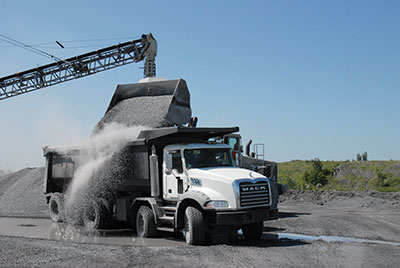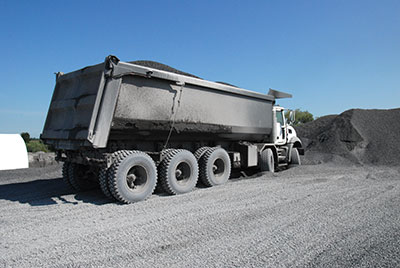
Features
Aggregates
Technology
Super Hauler
A new 50-tonne capacity off-road hauler is turning heads
September 29, 2014 By Carroll McCormick
A huge dump truck speeds away from a complex of towers, loading bins and
conveyors on the edge of a vast limestone quarry. Barely two minutes
later it is back for another load of 0-20 foundation stone.
A huge dump truck speeds away from a complex of towers, loading bins and conveyors on the edge of a vast limestone quarry. Barely two minutes later it is back for another load of 0-20 foundation stone.
 |
|
It is August, and the hauler, model name D-50T, is getting a two-week workout in the DJL Technologies quarry in St-Philippe, south of Montreal. It was built by DRAMIS, a company created last year by Simard Suspensions Inc. in Baie Saint-Paul, Quebec.
By the way, do not call it a dump truck.
“We don’t call them dump trucks,” says Edward Gosselin, chief operating officer, DRAMIS. “It’s a machine.” Its capabilities make its resemblance to a dump truck somewhat superficial.
“I’ve seen trucks, but I’ve never seen something like that. It is unbelievable,” enthuses Alain Miclette, DJL’s quarry foreman. After 30 years on the job, one has to believe that Miclette is not easily wowed. “I’m very impressed by this truck, the capacity, the speed, the ride. The suspension is unbelievable.”
The machine has two 23,000-pound, Mack FXL23 steer axles and AMS46THD front tandem suspension. The rock box sits on Triple Mack S652 axles with 10.1 ratio carriers and a 150,000-lbs Simard DTS hydraulic suspension. The transmission is an Allison 4500RDS-6 speed with retarder.
Empty, the D-50T weighs in at 24,440 kilograms. Loader operators are feeding it around 50 tonnes per load, but, says Gosselin, “We have instances where customers have loaded it with 65 tonnes, to test it. Carrying 55 tonnes is not an issue.”
It is about one kilometer from DJL’s aggregate plant to the hills of stockpiled 0-20. The D-50T makes the round trip in four to five minutes. “Yesterday, Jacques [the driver] stockpiled 2,400 tonnes in 48-50 trips,” says Miclette. There is a lot of performance packed into that statement.
First, the D-50T moves smoothly over the uneven ground at around 20 km/h. That is twice the speed that any highway-standard aggregate truck dare drive in the quarry. Its hydraulic suspension system allows each axle to move independently. The wheels do not bounce when they hit bumps and potholes
at speed.
Second, the D-50T has a tough traction task here: It is stockpiling 0-20, which is like marbles, according to Miclette. Just before hitting a ramp, Jacques slows to lock up the automatic transmission so it will not upshift. Then, 525 horses pull the machine up the 14%, or 12-degree, grade like it was flat ground. No spinning wheels, no hi-rev howling, just relentless climbing.
“This is the first contraption that can climb clean stone that is cubic. It is unbelievable. I tell other guys not to go up there, that they’ll get stuck. And then they do it and get stuck. The biggest problem we have in quarries are trucks coming in from outside, stockpiling. Twelve-wheelers can’t get on this pile. They try to build up speed and the truck will start bouncing. They can break an axle,” Miclette says.
Part of the D-50T’s traction secret is those three drive axles, but the rest is the hydraulic suspension. It gives all of the drive wheels maximum contact with the ground, and all possible traction is always available. “The weight is evenly distributed,” Miclette says.
Backing up in some loose 0-20, the four steer wheels, turned, plow the aggregate, but the machine does not get stuck. “It is pretty hard to sink it. It is unbelievable,” Miclette says.
The dump cycle for the 25-foot long by 8.5-foot wide rock box is just 21 seconds. DRAMIS, realizing that the longer the rock box, the greater the chance of a rollover on ground that is not level, has equipped the D-50T with an auto-leveling system. It corrects for up to seven degrees of roll left or right. If the roll is greater than that it will not dump, and the driver must reposition the machine to make it more level.
“I tested it on a hill. It raises nine to ten inches on one side. That is a lot. When it is auto correcting an alarm sounds until it is levelled. This auto leveling feature is something I’ve never seen before,” Miclette says.
The D-50T and its three sister models, the D-55T, D-60T and D-65T (the numbers refer to their capacity) have their genesis in a project initiated by Simard and Mack Trucks in 2010. Early discussions centered on the idea of building a 50-tonne capacity truck on a GU8 chassis.
Simard, founded in 1935, has more than a quarter-century-long relationship with Mack. Simard’s core business is the installation of twin and tri-steer axles as well as rear steer axles on new chassis of any Class 8 truck brand manufactured in North America. “In any given year, Simard will process up to 1,000 or more trucks. After the installation of the additional axles and suspension the chassis go back to the OEM installer for the work unit installation,” Gosselin says.
Mack withdrew from the project in 2013, but Simard arranged to continue on its own and build a product that was not represented as a Mack truck. “Simard decided to create a spin-off company, DRAMIS, to develop and market the truck independently,” Gosselin says.
“We looked at the market niche and the competition and decided we would build four models, using the technology that we had. The main components we fabricate are the new frame rail inserts, cross member beams and front and rear suspensions. We also have amalgamated other technologies. These four basic platforms are individually customized, depending on the type of material being hauled, as well as the distances being driven per dump cycle,” Gosselin explains.
DRAMIS has been offering big operators a taste of the D-50T and to evaluate its performance in real-life, no-holds-barred conditions. The D-50T had worked at five sites by the summer of 2014. At the Sitec silica mine near Baie Saint-Paul, says Gosselin, “The terrain is quite challenging in terms of slope. It performed very well and carried the load it needed to carry.”

|
|
| The D-50T moves smoothly over the uneven ground at around 20 km/h. That is twice the speed that any highway-standard aggregate truck dare drive in the quarry.
|
One D-50T spent last summer and fall at the La Romaine 2 hydroelectric construction site north of Havre-Saint-Pierre. “La Romaine was carrying rock, up to an average diameter of eight inches. There were grades up to 20 degrees. The truck was in the same environment as the rigids and articulated trucks. Because the stone was so sharp, we had to look at the tire performance. We had to make sure we had the right tires, and make sure the engine was OK with 10- to 20-degree grades,” Gosselin relates. “The unit was used in 1,366 cycles ranging from 1.8 kilometres to 9.6 kilometres, loaded at 55 tonnes per load, thus hauling more than 75,000 tonnes. It consumed 13,430 liters of fuel performing at 0.18 litres per tonne carried.”
The D-50T is carrying Michelin XXY3 WB 425/65R22 rubber up front and Bridgestone L317 12R24 tires in the drive positions.
Another D-50T spent four months last winter working for Kiewit Corporation in Glencor’s Raglan nickel mine in northern Quebec. “The Kiewet equipment manager told us he had been looking for a truck like this for 10 years. He thought it would take its place in a contractor’s equipment arsenal,” Gosselin notes.
The machine worked in -30 C conditions and 100 km/h winds. “We had to winterize some of the equipment, such as installing heating systems for the hydraulics and fluid tanks,” Gosselin says. “We ran 10-hour night shifts for 1,000 hours over four months. The unit hauled an average of 550 tonnes per shift compared to 385 tonnes for a CAT 770 for the same time.”
The D-50T costs less than many rigid haulers, according to Gosselin. Furthermore, he calculates that its speed, capacity, fuel consumption and other factors add up to a lower operating cost per tonne than that of other machines – e.g., the D-50T burns around 20 litres per hour, compared to as much as 58 litres/hour for other machines with similar capacity.
Owners of multiple quarries will appreciate that the D-50T is road legal. “A lot of family-operated companies will have two to three little pits and a portable crusher. The D-50T will just follow along. It cost $900 plus a special permit to move our 40-tonne Euclid Hitachi 45 kilometres to St-Bruno. We could move the D-50T for the cost of about 10 litres of fuel,” Miclette calculates. And, he adds, “You can repair a Mack truck at almost every street corner.”
“The D-50T bridges the gap between traditional dump trucks and heavy rigid haulers,” Gosselin says. “In many applications, the cost-per-ton of rigid haulers as well as their capital investments are no longer needed or justifiable with the technology we have built into our machines.”
Print this page